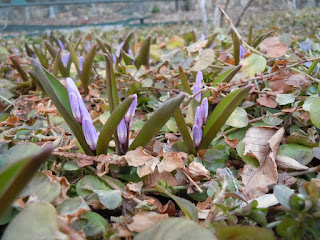That would be Waccabuc. Home.
I realize that there's no point in bitching and whining about this. Mother Nature has done much worse recently in many places around the globe. So instead, I'm going to focus on the appearance of the first bloom of the season: my Chionodoxa Forbesii. These are very tiny, very early spring bulbs that I've interplanted with a carpet of Creeping Jenny -- the groundcover that blankets the front garden under an oak tree. Creeping Jenny is so thick and dense it's almost like a coat of mail. Very little is compatible with it, and it smothers most competitors. Chionodoxa outfoxes it by slipping a small tough, spearlike shoot unnoticed through the tangle, surfacing through the mat like a periscope breaching the ocean. The plant isn't physically imposing. It's only about two inches, but it populates the not-yet-green ground cover with pinpoints of lovely star-shaped periwinkle blooms, giving the garden its first real color of the season.
 |
| Chionodoxa Forbesii |
When I got home from work last night, I noticed the Chionodoxa had opened -- not fully yet, but it's clear that there's something other than gray or green about to burst. So I ran right out to snap a picture before it gets covered up in the imminent precipitation. I realized, however, that even if it does, it will be absolutely fine. The common name is,after all, Glory of the Snow.
So there, Mother Nature.

















